wiper blades FORD THUNDERBIRD 2003 11.G Owners Manual
[x] Cancel search | Manufacturer: FORD, Model Year: 2003, Model line: THUNDERBIRD, Model: FORD THUNDERBIRD 2003 11.GPages: 200, PDF Size: 1.79 MB
Page 21 of 200
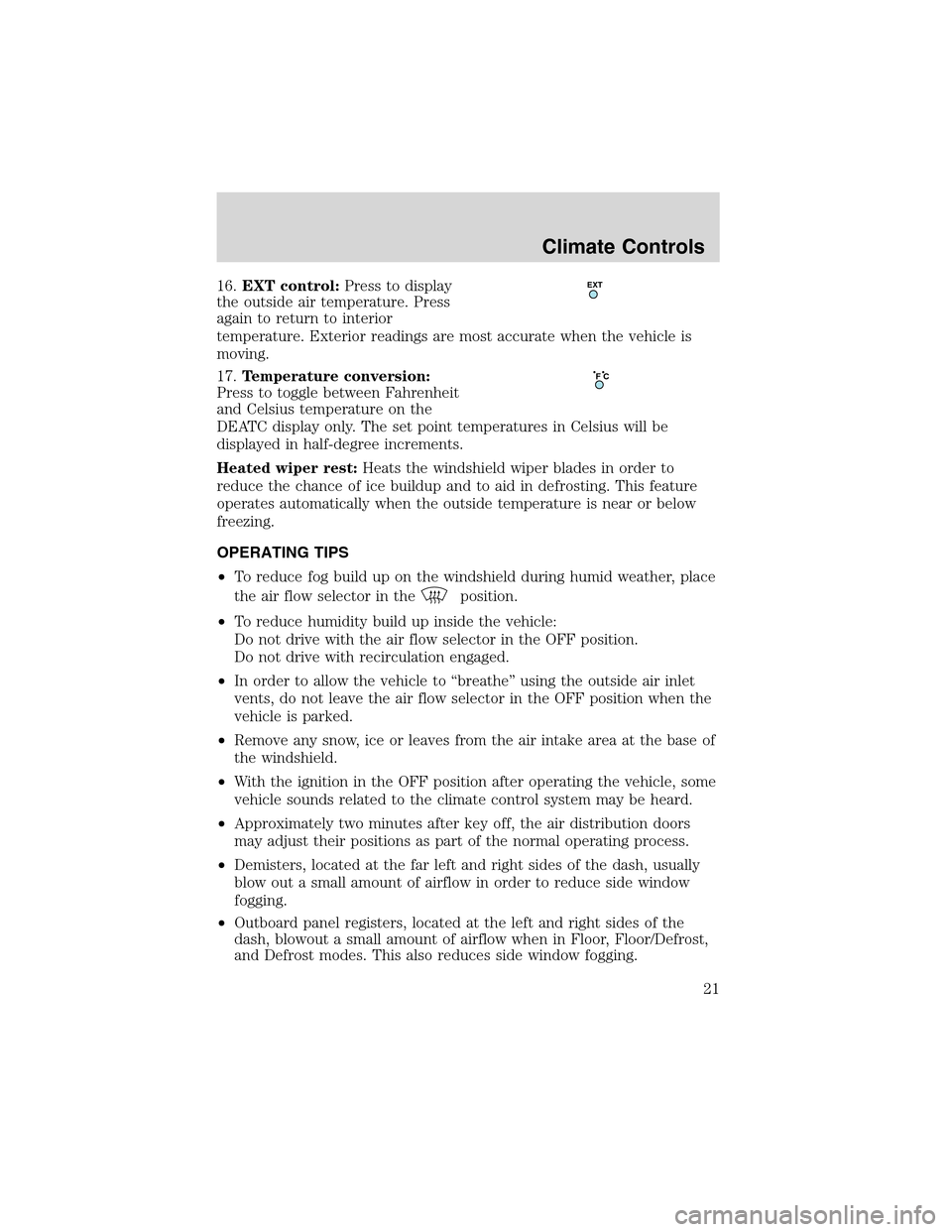
16.EXT control:Press to display
the outside air temperature. Press
again to return to interior
temperature. Exterior readings are most accurate when the vehicle is
moving.
17.Temperature conversion:
Press to toggle between Fahrenheit
and Celsius temperature on the
DEATC display only. The set point temperatures in Celsius will be
displayed in half-degree increments.
Heated wiper rest:Heats the windshield wiper blades in order to
reduce the chance of ice buildup and to aid in defrosting. This feature
operates automatically when the outside temperature is near or below
freezing.
OPERATING TIPS
•To reduce fog build up on the windshield during humid weather, place
the air flow selector in the
position.
•To reduce humidity build up inside the vehicle:
Do not drive with the air flow selector in the OFF position.
Do not drive with recirculation engaged.
•In order to allow the vehicle to“breathe”using the outside air inlet
vents, do not leave the air flow selector in the OFF position when the
vehicle is parked.
•Remove any snow, ice or leaves from the air intake area at the base of
the windshield.
•With the ignition in the OFF position after operating the vehicle, some
vehicle sounds related to the climate control system may be heard.
•Approximately two minutes after key off, the air distribution doors
may adjust their positions as part of the normal operating process.
•Demisters, located at the far left and right sides of the dash, usually
blow out a small amount of airflow in order to reduce side window
fogging.
•Outboard panel registers, located at the left and right sides of the
dash, blowout a small amount of airflow when in Floor, Floor/Defrost,
and Defrost modes. This also reduces side window fogging.
EXT
F C
Climate Controls
21
Page 35 of 200
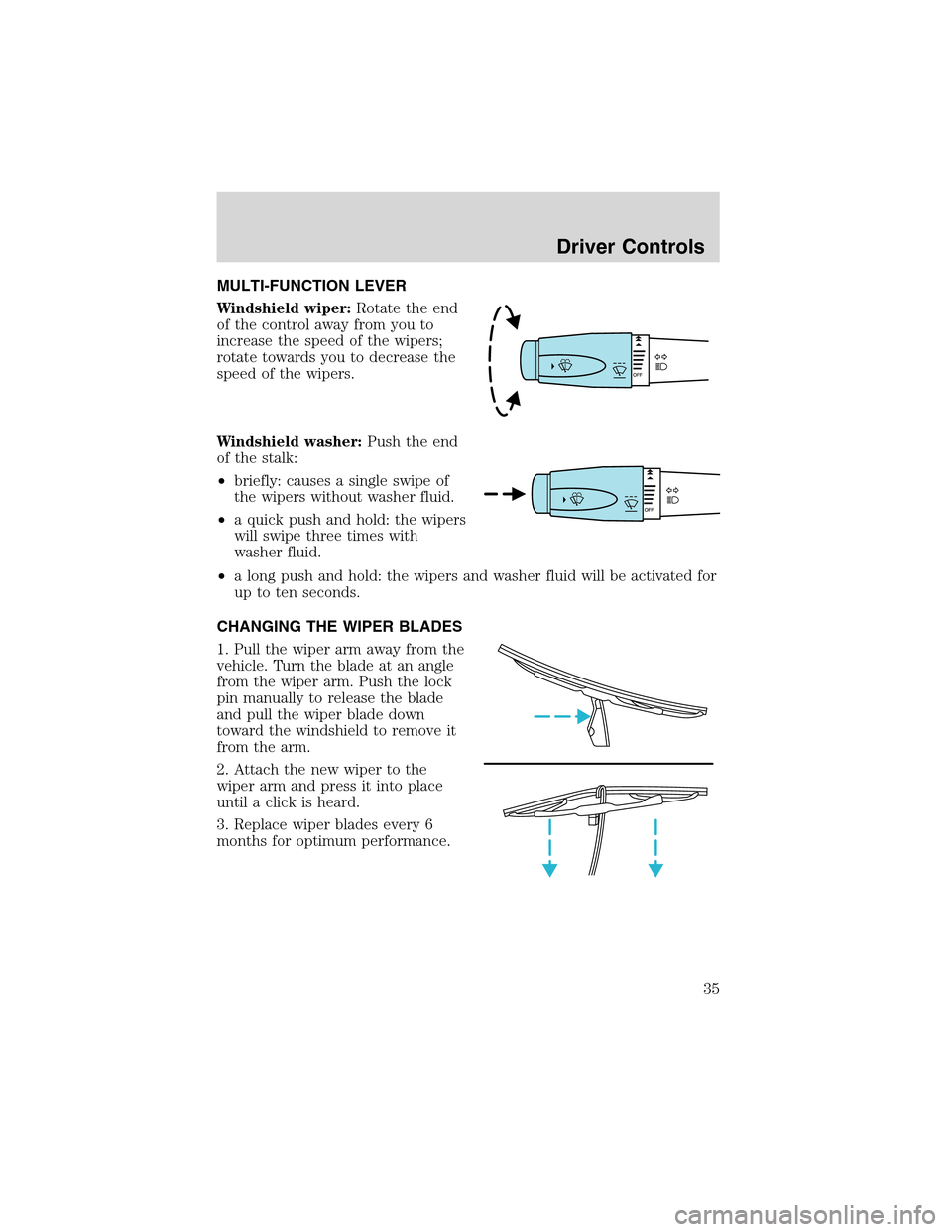
MULTI-FUNCTION LEVER
Windshield wiper:Rotate the end
of the control away from you to
increase the speed of the wipers;
rotate towards you to decrease the
speed of the wipers.
Windshield washer:Push the end
of the stalk:
•briefly: causes a single swipe of
the wipers without washer fluid.
•a quick push and hold: the wipers
will swipe three times with
washer fluid.
•a long push and hold: the wipers and washer fluid will be activated for
up to ten seconds.
CHANGING THE WIPER BLADES
1. Pull the wiper arm away from the
vehicle. Turn the blade at an angle
from the wiper arm. Push the lock
pin manually to release the blade
and pull the wiper blade down
toward the windshield to remove it
from the arm.
2. Attach the new wiper to the
wiper arm and press it into place
until a click is heard.
3. Replace wiper blades every 6
months for optimum performance.
Driver Controls
35
Page 150 of 200
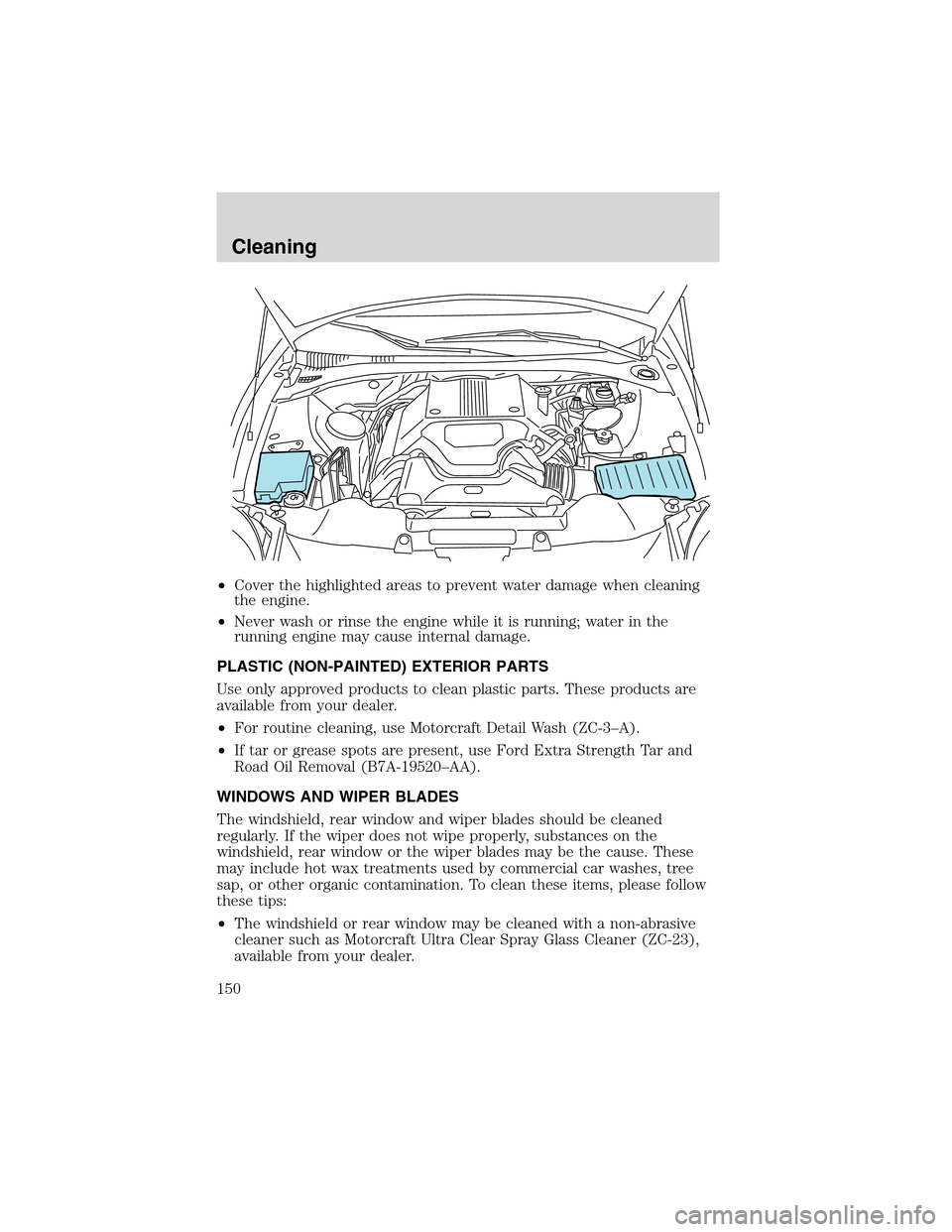
•Coverthehighlightedareas to prevent water damage when cleaning
the engine.
•Never wash or rinse the engine while it is running; water in the
running engine may cause internal damage.
PLASTIC (NON-PAINTED) EXTERIOR PARTS
Use only approved products to clean plastic parts. These products are
available from your dealer.
•For routine cleaning, use Motorcraft Detail Wash (ZC-3–A).
•If tar or grease spots are present, use Ford Extra Strength Tar and
Road Oil Removal (B7A-19520–AA).
WINDOWS AND WIPER BLADES
The windshield, rear window and wiper blades should be cleaned
regularly. If the wiper does not wipe properly, substances on the
windshield, rear window or the wiper blades may be the cause. These
may include hot wax treatments used by commercial car washes, tree
sap, or other organic contamination. To clean these items, please follow
these tips:
•The windshield or rear window may be cleaned with a non-abrasive
cleaner such as Motorcraft Ultra Clear Spray Glass Cleaner (ZC-23),
available from your dealer.
Cleaning
150
Page 151 of 200
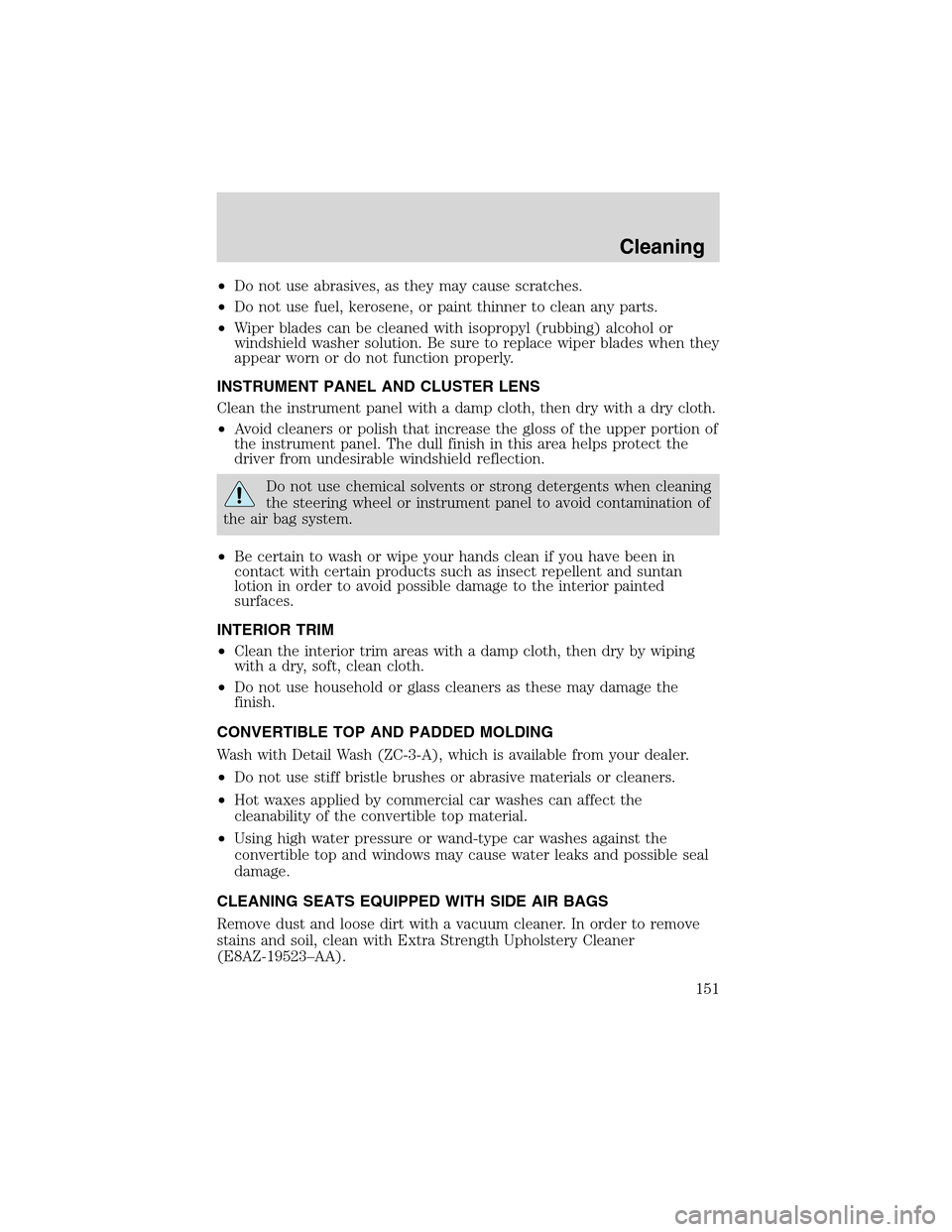
•Do not use abrasives, as they may cause scratches.
•Do not use fuel, kerosene, or paint thinner to clean any parts.
•Wiper blades can be cleaned with isopropyl (rubbing) alcohol or
windshield washer solution. Be sure to replace wiper blades when they
appear worn or do not function properly.
INSTRUMENT PANEL AND CLUSTER LENS
Clean the instrument panel with a damp cloth, then dry with a dry cloth.
•Avoid cleaners or polish that increase the gloss of the upper portion of
the instrument panel. The dull finish in this area helps protect the
driver from undesirable windshield reflection.
Do not use chemical solvents or strong detergents when cleaning
the steering wheel or instrument panel to avoid contamination of
the air bag system.
•Be certain to wash or wipe your hands clean if you have been in
contact with certain products such as insect repellent and suntan
lotion in order to avoid possible damage to the interior painted
surfaces.
INTERIOR TRIM
•Clean the interior trim areas with a damp cloth, then dry by wiping
with a dry, soft, clean cloth.
•Do not use household or glass cleaners as these may damage the
finish.
CONVERTIBLE TOP AND PADDED MOLDING
Wash with Detail Wash (ZC-3-A), which is available from your dealer.
•Do not use stiff bristle brushes or abrasive materials or cleaners.
•Hot waxes applied by commercial car washes can affect the
cleanability of the convertible top material.
•Using high water pressure or wand-type car washes against the
convertible top and windows may cause water leaks and possible seal
damage.
CLEANING SEATS EQUIPPED WITH SIDE AIR BAGS
Remove dust and loose dirt with a vacuum cleaner. In order to remove
stains and soil, clean with Extra Strength Upholstery Cleaner
(E8AZ-19523–AA).
Cleaning
151
Page 156 of 200
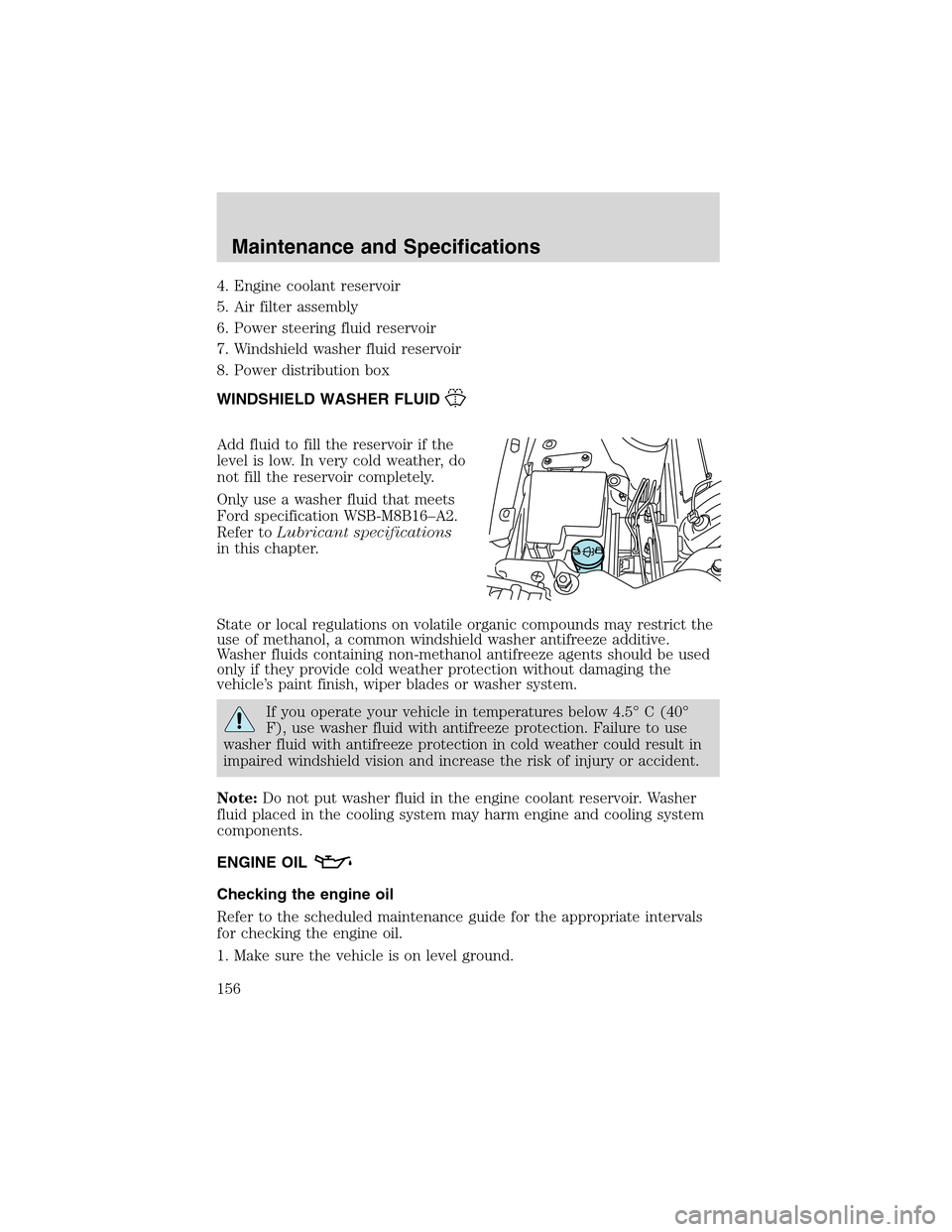
4. Engine coolant reservoir
5. Air filter assembly
6. Power steering fluid reservoir
7. Windshield washer fluid reservoir
8. Power distribution box
WINDSHIELD WASHER FLUID
Add fluid to fill the reservoir if the
level is low. In very cold weather, do
not fill the reservoir completely.
Only use a washer fluid that meets
Ford specification WSB-M8B16–A2.
Refer toLubricant specifications
in this chapter.
State or local regulations on volatile organic compounds may restrict the
use of methanol, a common windshield washer antifreeze additive.
Washer fluids containing non-methanol antifreeze agents should be used
only if they provide cold weather protection without damaging the
vehicle’s paint finish, wiper blades or washer system.
If you operate your vehicle in temperatures below 4.5°C (40°
F), use washer fluid with antifreeze protection. Failure to use
washer fluid with antifreeze protection in cold weather could result in
impaired windshield vision and increase the risk of injury or accident.
Note:Do not put washer fluid in the engine coolant reservoir. Washer
fluid placed in the cooling system may harm engine and cooling system
components.
ENGINE OIL
Checking the engine oil
Refer to the scheduled maintenance guide for the appropriate intervals
for checking the engine oil.
1. Make sure the vehicle is on level ground.
Maintenance and Specifications
156
Page 192 of 200
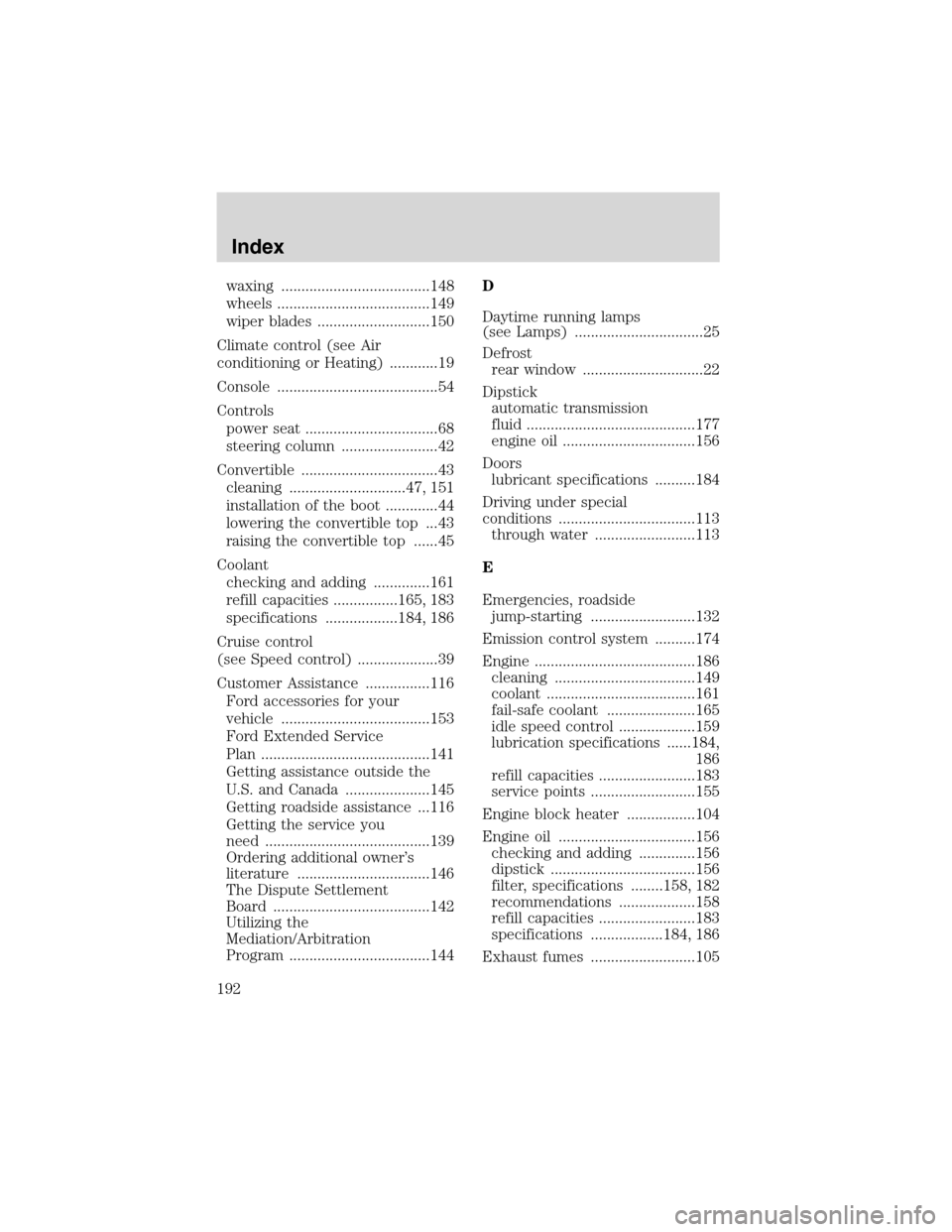
waxing.....................................148
wheels ......................................149
wiper blades ............................150
Climate control (see Air
conditioning or Heating) ............19
Console ........................................54
Controls
power seat .................................68
steering column ........................42
Convertible ..................................43
cleaning .............................47, 151
installation of the boot .............44
lowering the convertible top ...43
raising the convertible top ......45
Coolant
checking and adding ..............161
refill capacities ................165, 183
specifications ..................184, 186
Cruise control
(see Speed control) ....................39
Customer Assistance ................116
Ford accessories for your
vehicle .....................................153
Ford Extended Service
Plan ..........................................141
Getting assistance outside the
U.S. and Canada .....................145
Getting roadside assistance ...116
Getting the service you
need .........................................139
Ordering additional owner’s
literature .................................146
The Dispute Settlement
Board .......................................142
Utilizing the
Mediation/Arbitration
Program ...................................144D
Daytime running lamps
(see Lamps) ................................25
Defrost
rear window ..............................22
Dipstick
automatic transmission
fluid ..........................................177
engine oil .................................156
Doors
lubricant specifications ..........184
Driving under special
conditions ..................................113
through water .........................113
E
Emergencies, roadside
jump-starting ..........................132
Emission control system ..........174
Engine ........................................186
cleaning ...................................149
coolant .....................................161
fail-safe coolant ......................165
idle speed control ...................159
lubrication specifications ......184,
186
refill capacities ........................183
service points ..........................155
Engine block heater .................104
Engine oil ..................................156
checking and adding ..............156
dipstick ....................................156
filter, specifications ........158, 182
recommendations ...................158
refill capacities ........................183
specifications ..................184, 186
Exhaust fumes ..........................105
Index
192
Page 196 of 200
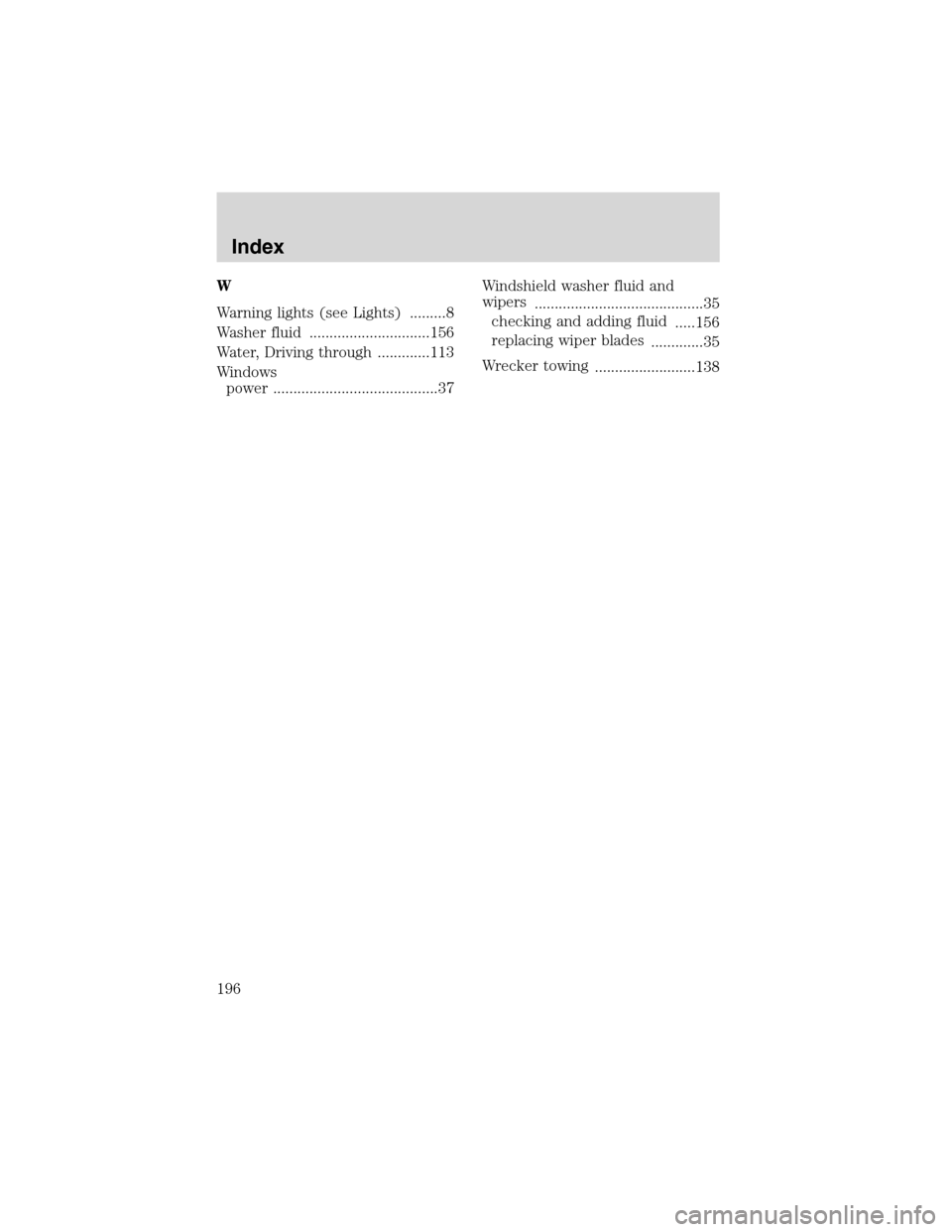
W
Warninglights(seeLights) .........8
Washer fluid ..............................156
Water, Driving through .............113
Windows
power .........................................37Windshield washer fluid and
wipers
..........................................35
checking and adding fluid
.....156
replacing wiper blades
.............35
Wrecker towing
.........................138
Index
196